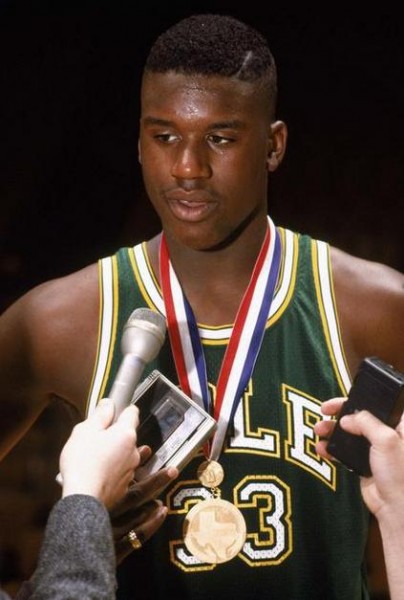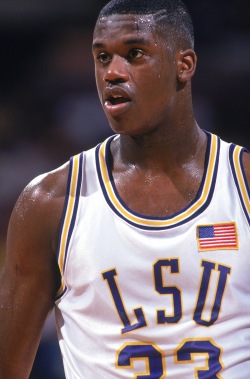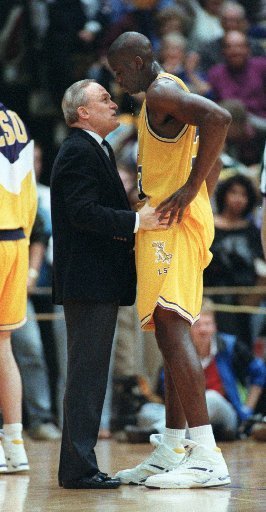The Goofball Goliath Arrives: Shaq’s Freshman Season at LSU
Posted by JWeill on November 9th, 2011Past Imperfect is a series focusing on the history of the game. Every two weeks, RTC contributor Joshua Lars Weill (@AgonicaBoss|Email) highlights some piece of historical arcana that may (or may not) be relevant to today’s college basketball landscape. This week: the arrival of Shaquille O’Neal in college basketball.
Quick: What’s the biggest thing you’ve ever seen right in front of you? Was it’s a skyscraper, or maybe a mountain? Or maybe it was a waterfall or an ancient castle? But what if it was an 18-year-old kid in sneakers wearing a wide, toothy grin?
That’s what a lot of folks around the SEC saw back in 1989 when this… kid showed up. He wasn’t just big, he was huge. Never mind that he couldn’t yet spin in the lane like he eventually would or that his shot from more than four feet was not going to go in. He didn’t have to be there yet. LSU had other guys for that stuff, especially All-Everything guard Chris Jackson. Instead, the huge kid with the weird name was just supposed to do exactly what he did do: absolutely terrify opposing coaches away from the paint.
What kind of name was ‘Shaquille’ anyway? (Muslim, actually, for ‘little one’ … wait, little?). And where did he come from? (San Antonio, actually, well, by way of Germany, by way of New Jersey by… well, it doesn’t even really matter.) All those details, they didn’t help you shoot over him or grab a rebound when he was anywhere near the rim. That you knew who he was or where he was from didn’t make you any more likely to move him out of the paint. Most likely, nothing would have.
That Shaquille Rashaun O’Neal ended up arriving on campus at Baton Rouge is a fantastic story unto itself and, like everything with the kid who would soon go by ‘Shack,’ it’s ultimately a tale of the tape.
It was 1985 – smack dab in the center of the great era of college basketball big men. Patrick Ewing dominated college ball at Georgetown. Ralph Sampson was a four-time college All-American. Hakeem Olajuwon redefined the position at Houston. As LSU coach Dale Brown has told it many hundreds of times, he was a world away from all that, wrapping up a basketball clinic at a military base in West Germany in a town called Wildflecken, when this lean 6’8” guy in a white polo shirt, khakis and sneakers came up to ask Brown some advice on improving his conditioning.
“How long you been in the service, son?” Brown asked him.
He replied, “I’m too young for the service, sir. I’m only 13.”
Working his best poker face, Brown answered famously, “So you’re 13. I’d sure like to meet your dad.” Which the overwhelmed and giddy Brown eventually did.
But being 6’8” at 13 isn’t easy. There’s a reason even a basketball coach would do a triple-take. His lack of motor coordination at that age got O’Neal got cut from the basketball team his freshman year; told, in fact, that he might consider being a goalie in soccer as a better option. O’Neal instead pressed on. That is why he was asking this coach he didn’t know how to get stronger in his lower body. Which is how Dale Brown, coach of the LSU Tigers about to be on his way back from Germany, happened to meet the future face of his program by absolute happenstance.
Which isn’t to say that it was ever that easy. Maybe Brown had the first contact, but he still had to stay in touch regularly because O’Neal didn’t stay a secret stashed away in Germany for long. When his stepfather, the man O’Neal considered his real father, a military man, a drill instructor named Phillip Harrison, was re-assigned to Ft. Sam Houston in Texas, Shaquille and his family settled into San Antonio. By now, the big kid was even bigger – 6’10” and still growing. His shoes could just about hold a toddler each. He enrolled at Cole High School. One can only imagine the heart-stopping joy that Cole High School’s unsuspecting coach Ken Kuwamura must have felt the day the Goliath fall into his lap.
Thing is, this Goliath didn’t act like a Goliath. He was more of a Gallagher. A big, jokey, goofball character that just happened to be able to dunk without effort and block every shot in the gym. He was Cole High’s unofficial mascot. He became the football team statistician and bench-pressed his principal as a lark. That 10,000-watt smile of his made you forget you were in the presence of a freak of nature. Because that’s really what he was. No human is supposed to be so big and so nimble. No one is supposed to be able to jump like that on limbs so overwhelmingly long and large. And yet, Shaquille O’Neal did just that.
Whatever clownishness the big kid displayed on or off the court, he was utterly dominant at basketball. In his junior season, O’Neal led Cole to a 31-1 record. But that wasn’t enough. Too small an accomplishment for so big a boy, so big a personality as O’Neal. Because not only had the kid blossomed into a mammoth basketball player, his megawatt persona – what the world would eventually know as simply “Shaq” had begun to emerge, too.
As a senior, with dozens of coaches slobbering for a chance to add the best big man in America not named Ewing, Robinson, Olajuwon or Sampson, Shaquille stepped it up a notch, posting video game-like numbers on his way to being named a McDonald’s All-American. He averaged over 32 points and snared 22 rebounds a game that season. More importantly for the uber-competitive O’Neal, his team went undefeated, winning 36 in a row and the Texas 3A state title. Few watching from the stands or at home could have guessed that it would be O’Neal’s only title on any level for another decade. He was as unstoppable as a high school center could really be.
All the while, Dale Brown hoped his diligence, and his luck, would help reel in the big kid he’d met in an that little gym in Europe years before. Eventually, despite also seriously considering Louisville, N.C. State, North Carolina and UNLV, young Shaquille went with the man who’d shown him loyalty and signed with Brown’s LSU Tigers.
It would have been easy for O’Neal to make demands on his new coach. Plenty of kids in his position would have, and certainly did. Start me. Run the offense through me, coach. Let me be The Man. But that wasn’t Shaquille’s style. He saw that fitting into a team – something he’d been instructed in by Sgt. Harrison since he was three – was befitting a freshman, even one as big and as heralded as he was. So he told Coach Brown he would do the dirty work: rebounding and blocking shots. Let All-American Chris Jackson take his shots. Let redshirt freshman Stanley Roberts get the ball down low on offense. I’ll do what is asked of me … for now. Brown said OK, and then let him do all three. Why not?
It’s rather remarkable now to look back, all these years later, and even fathom that O’Neal was once any team’s third option. But that was exactly the case as a freshman for the 1989-90 Tigers. It’s the way Shaquille wanted it. He learned, he worked, he got better and stronger and, yes, even bigger. Playing against Roberts improved his offensive game. There were few men in college basketball – heck, anywhere, really – who could body up the 17-year-old O’Neal. One of them just happened to always be in the same gym as O’Neal. Years later, when Shaq was the NBA’s dominant force and Roberts was out of the game, a victim of high expectations and low will power, it would be Shaq reminding everyone that Roberts had first been the dominant one, not him. No one would defend Roberts as a player more vehemently than O’Neal. No one could have made him a better player physically.
By the time the season opened, big things were expected of O’Neal and of his team. The Associated Press picked them preseason No. 2 in the land, behind just overwhelming national favorite UNLV. The addition of O’Neal and the Prop 48 redshirted Roberts to Jackson was impossible to ignore. But it only took two games to show that perhaps three ultra-talented players were not enough to guarantee wins.
Kansas stopped LSU cold, 89-83 in Game 2, a preseason NIT home game that the Tigers were expected to walk through on their way to a trip to New York City. But Kansas’ no-names shot their way past LSU’s big stars and spoiled the party.
It was a learning experience for the young Shaq. In just his fourth game, against Lamar, O’Neal scored 26 points, despite not starting the game. He continued to get better and more confident. O’Neal had his first triple double – with an SEC-record 10 blocks — in a win over Southwestern Conference power Texas, in Houston right after New Year’s. By February, the monster freshman would record a triple double in an overtime win over nationally ranked Loyola Marymount and it’s gimmicky run-and-gun offense, including 20 points, 24 rebounds and 12 blocked shots. O’Neal tallied 20 points, 14 rebounds and 5 blocked shots in a regular season-ending win over Mississippi.
But against Auburn in the SEC tournament, a team LSU had beaten twice already that season, something went awry. A three-pointer with just five seconds left lifted Auburn to a 78-76 upset win in LSU’s opening (and closing) game of the conference tourney. The loss would bode ill for Shaq and his teammates, a sign that no one was going to just lay down before the size of LSU’s interior and the shooting of Jackson.
In fact, all season Louisiana State lost some games they probably should have won, like the Auburn game, and thus wound up receiving a No. 5 seed in the NCAA tournament. Seeding is important, as a pairing in the second round that would prove disastrous for the talented but erratic Tigers proved.
Plus, All-American guard Chris Jackson was hurt. Nursing a sore shoulder that required playing under medication, Jackson wasn’t his usual off-the-charts self in either the Tigers’ opening game or in their second round matchup with Georgia Tech. With Jackson ailing, LSU would have to try and beat the talented Yellow Jackets with only two-thirds of their regular arsenal intact. Offensively, that didn’t end up hurting them as much as the fact that LSU couldn’t stop Georgia Tech from scoring, even with Shaq and Roberts plugging the lane.
After tying the score at 89 with a free throw, on the last of O’Neal’s 19 points on the game, LSU briefly took a final lead at 91-90 with just 1:47 remaining. But after Georgia Tech’s own stupendous freshman Kenny Anderson made a jumper with just over a minute and a half left, the Yellow Jackets held a lead they wouldn’t lose.
Trailing by one, the Tigers tried to get the ball down low to O’Neal or Roberts, but with Jackson on the bench having fouled out, Georgia Tech smartly left it up to the other Tigers to beat them, and they couldn’t. Vernel Singleton’s jumper was off, Tech rebounded, added a free throw and the magical freshman season of Shaquille O’Neal came to an end. The big kid’s final line? Not bad: 19 points, 14 rebounds and 4 blocked shots. But it was in a loss.
It remains one of basketball’s great mysteries that Dale Brown was unable to get a team with Jackson, Roberts and O’Neal past the NCAA tournament’s first weekend. There are reasons. LSU’s loss to Georgia Tech was close – by just a single bucket – and to a team that was as hot as any in America just then. That Tech team was better than its record, featuring the famed ‘Lethal Weapon Three’ of Anderson, Brian Oliver and Dennis Scott. Not exactly a cakewalk in the second round of the tournament. Still, LSU had underachieved, even with its star freshman center producing more than enough numbers to satisfy expectations.
The numbers and accolades for O’Neal’s rookie NCAA season don’t lie. He led the SEC in blocks and rebounds. National freshman All-America. Honorable mention All-American by the AP and UPI. Unanimous First-team All-Conference selection. An SEC-record 115 blocked shots – the first ever over 100 blocks in a single season. Two triple doubles, the first freshman ever to do it twice.
Nope, not bad at all. Of course, immediately after the NCAA loss, Jackson announced he was going pro and Roberts eventually did so too, albeit to play in Europe. And suddenly there was just one of the big three Tigers left, the biggest one: Shaquille O’Neal. Only now he was ‘Shaq.’ And he was hungry. And he was still huge. SEC coaches would spend the offseason waking in a cold sweat.
The others had their chance. Now it would be Goliath’s turn. Grinning all the while.













































